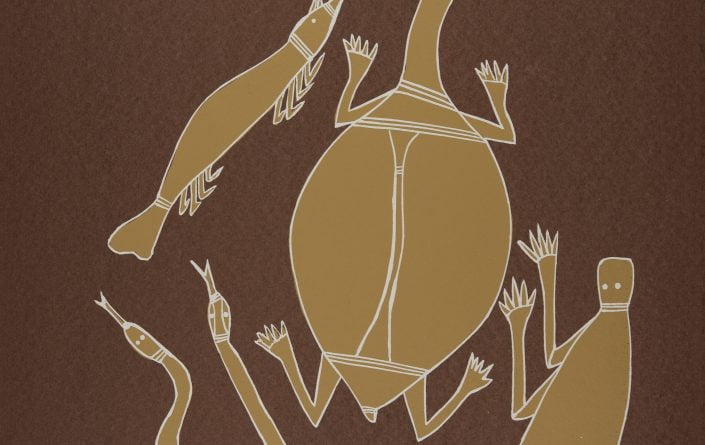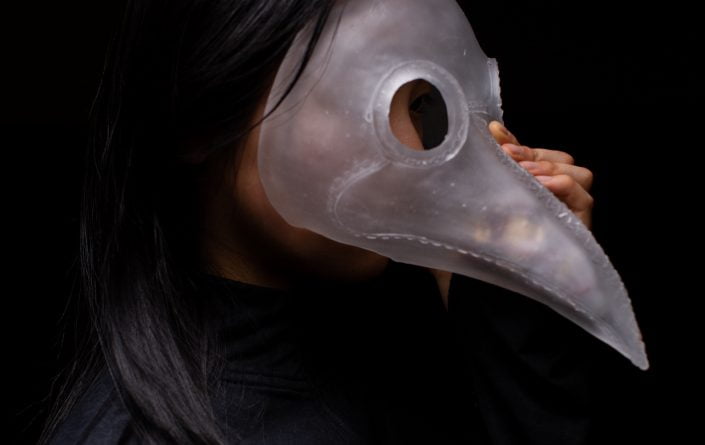John Bulunbulun
Born in 1946, near the Arafura swamp in central Arnhem Land, Johnny Bulunbulun’s country was Ngaliyindi and his clan was Gurrambakurramba. Bulunbulun was a ceremonial leader and one of the most eminent singers and ceremonial men in North-Central Arnhem Land, he was the ‘boss’ for Marradjiri (birth of a child), Djapi(young boy’s initiation) and Murrkundjeh (mortuary/funeral) ceremonies.
Bulunbulun was trained in ceremony by his second father acclaimed bark painter George Milpurru (b.1934 d.1998) and he apprenticed under his father Ngarritj and his uncle Peter Bandjurldjurl in the creation of painting and carving. When Bulunbulun was a young man, after his initiation, he and his family moved from their country at Ngalyindi to Nangalala on the Arnhem Land mainland. When Bulunbulun’s father passed away he moved to Maningrida to live with his uncles.
After moving to Maningrida, Bulunbulun left painting as he grieved for his father. He worked as a carpenter building new houses in the emerging community, at the sawmill, as a plumber, working with the local store delivering food for sale out bush and as part of a team driving bullock from Maningrida to Bulman. During this time he met his first wife Nelly (dec), Jack Wunuwun’s sister. He built a bark hut in Maningrida and commenced work at the still emergent Art Centre being the first Indigenous Artworker. He returned to his art practice, applying what he had learnt from his father and under the watchful eyes of his uncles Peter Bandjurldjurl and George Garrawun.
Upon the arrival of Bulunbulun’s first son, he relocated to Nelly’s country at Gamerdi. At Gamerdi and nearby Wurdeja outstation were artists’ Jack Wunuwun, Michael Ngalabiya, Michael Gadjarwala, Jimmy An.gunguna and Tommy Gondorra Steele. The work produced by these men (Wunuwun and Bulunbulun in particular) at this time was unprecedented in terms of highlighting the art of the region, of Arnhem Land and Aboriginal and Torres Strait Islander art in general to audiences nationally and internationally. The work that they did and their generosity of spirit put Maningrida Arts & Culture artists and the art centre itself on the map.
It was during this time, this gathering/school of artists at Gamerdi, that Bulunbulun honed his skills and perfected what were to become and remain the trademarks of his work; the initial drawing, the achievement of a perfect balance and symmetry of seemly complex motifs to form an overall equilibrium reflecting the natural harmony of his country and djang; the meticulous layering of rarrk executed with brushes made up of just two or three strands of reed; the graphic ‘body designs’ from Marradjiri, Djapi and Murrkundjeh ceremonies; the mammoth hollow log coffins taking up to six months to complete; the graphic simplicity of works depicting utilitarian items such as hunting knives and rifles and an ongoing exploration and experimentation with screen printing and lithography.
In 1979, Johnny Bulunbulun and David Milaybuma produced the first limited edition prints by Aboriginal artists to be marketed widely, at Port Jackson Press. In 1983, Johnny Bulunbulun and England Banggala were among the first Aboriginal artists to experiment with lithography, at the Printmaking Workshop in the Canberra School of Art.
Throughout the 1980’s Bulunbulun collaborated with other artist from Maningrida, nationally & internationally (most notably, Lin Onus) with academics (most notably, the National Museum of Ethnology, Osaka, Japan) and filmmakers (Curtis Levy and John Darling).
In 1989 he successful took action against R & T Textiles, a Queensland t-shirt manufacture, after they illegally reproduced one of his works ‘Magpie Geese and Water Lilles at the Waterhole’. The case Bulun Bulun v R & T Textiles, [1998] ALR 157 become a landmark in Indigenous intellectual property rights.
During the 1990’s Bulunbulun was featured in surveys of Aboriginal and Torres Strait Islander art; at the national state galeries in USA, Japan and Germany. In 1992, he lead a group of ten performers to Makassar (Ujung Padang) and Kupang in West Timor to perform the Ganalbingu ceremony of diplomacy and friendship to the Macassar people of South Sulawesi. For many hundreds of years, Macassar seafarers made annual visits to the North Australian coast and trade economies developed with Arnhem Land people. The Marayarr Murrukundja ceremony reflects this long history of pre-European contact. In 1998 the Macassan trade economy with his people was the subject of Bulunbulun’s large scale commission cast work, ‘Ganalpingu Cosmology’ at the Macquarie Bank, George St in Sydney.
In the early 2000’s his work was exhibited in Spain, France and the Netherlands. In 2001 Bulunbulun won the Bark Painting section of the Telstra National Aboriginal & Torres Strait Islander Art Award.
In 2004 he was the recipient of the Red Ochre Award. It is awarded annually by the Australia Council for the Arts to an outstanding Aboriginal and Torres Strait Islander artist for lifetime achievement.


